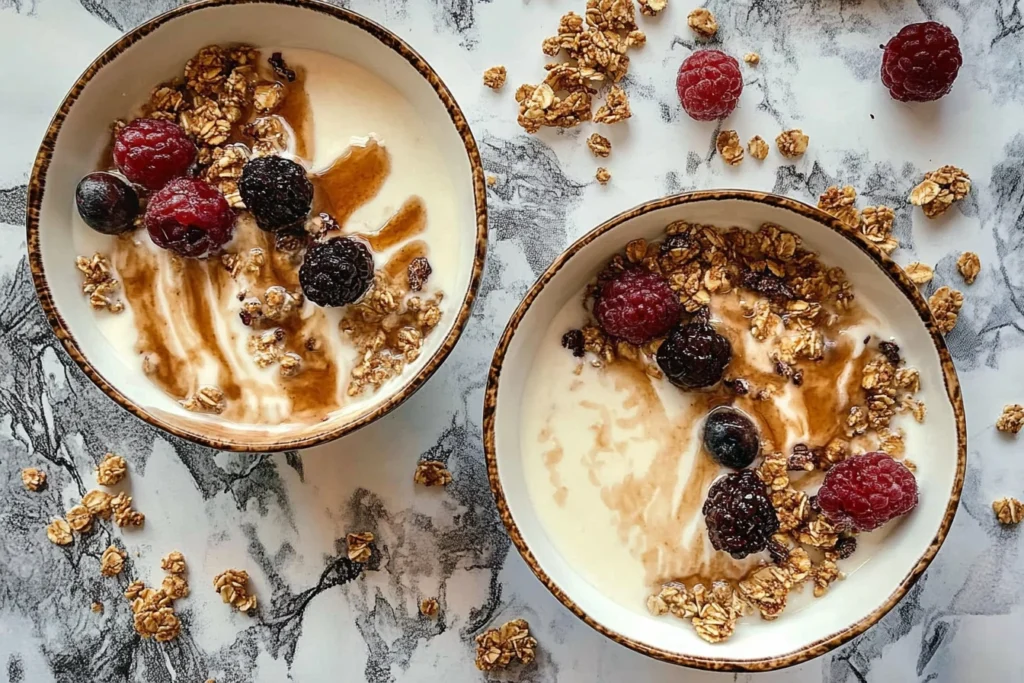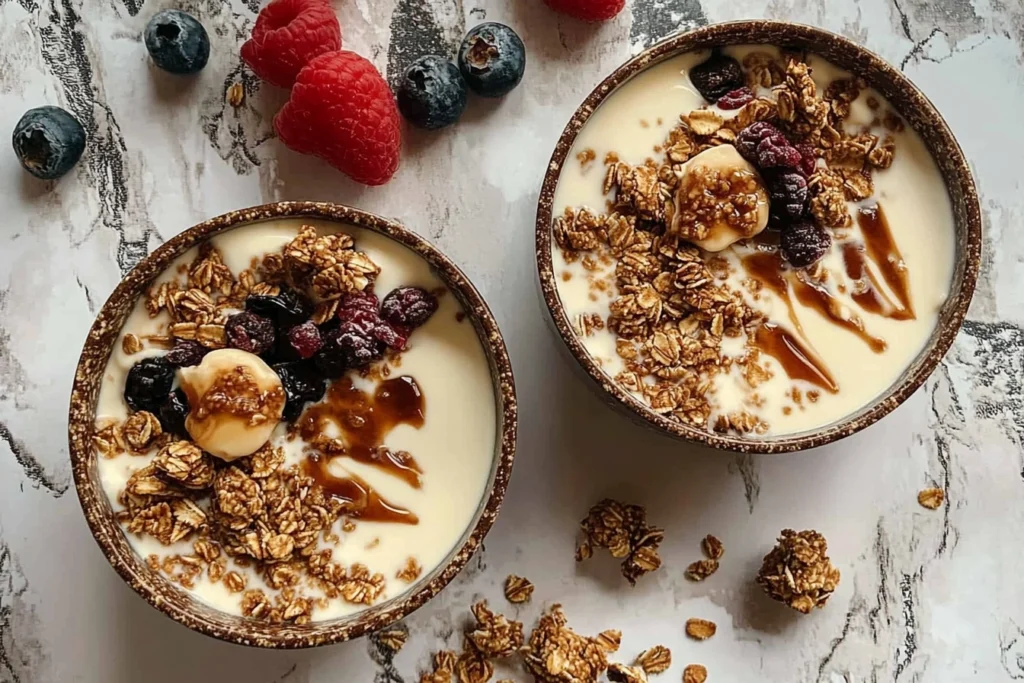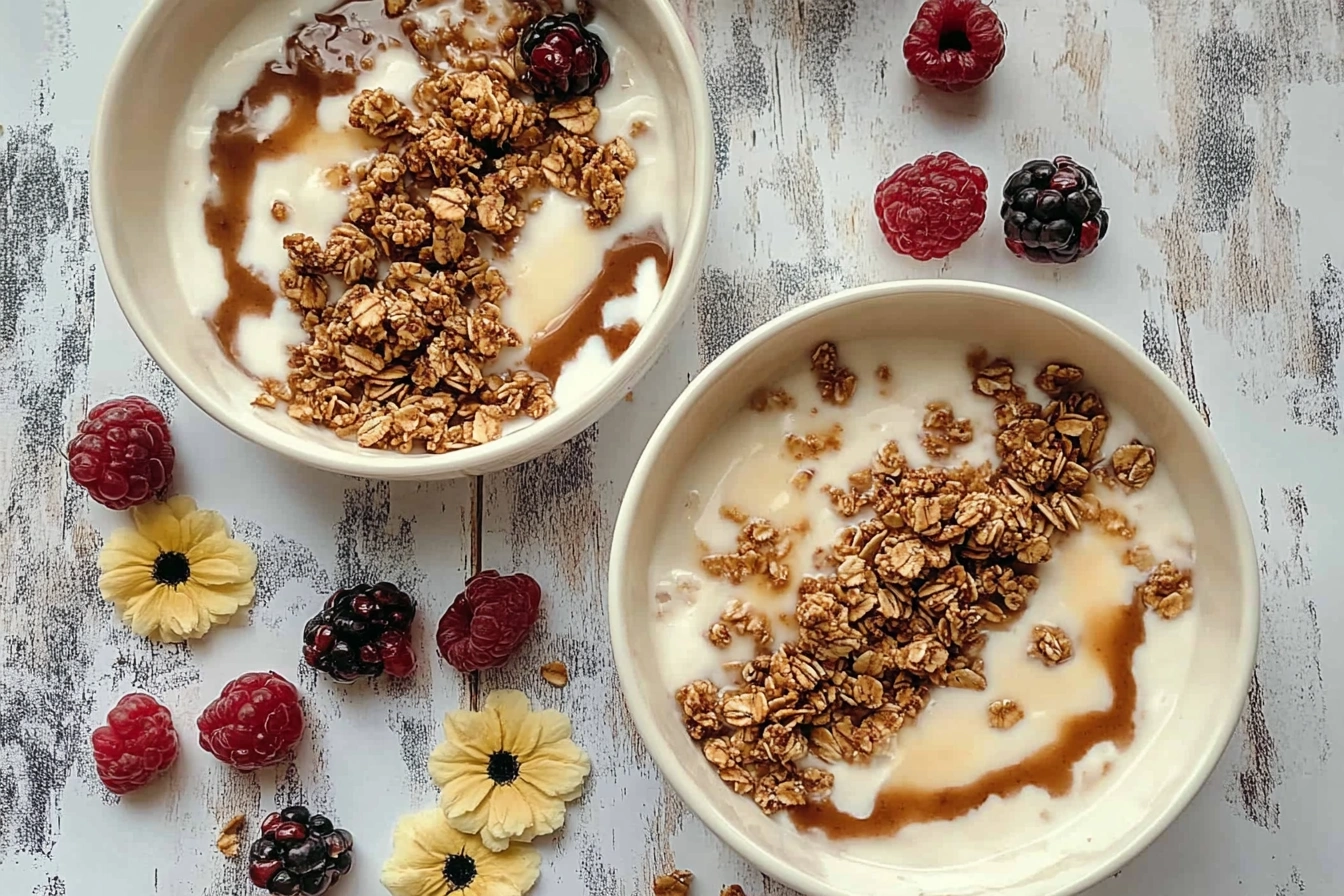Is vanilla yogurt with granola healthy? This is a question many breakfast lovers ponder as they enjoy their morning bowls. Combining creamy yogurt with crunchy granola is undeniably delicious, but understanding its actual health impact requires looking at the nutritional details, potential benefits, and some drawbacks. This article aims to provide an in-depth look at how this popular breakfast option fits into a balanced diet, offering tips to make it even healthier. Let’s get started!
Understanding the Popularity of Vanilla Yogurt with Granola
A Common Breakfast Choice
Vanilla yogurt paired with granola has become a breakfast staple, and it’s no wonder. It’s quick to prepare, full of flavor, and customizable with fruits, nuts, or seeds. This combination is perfect for people on the go, offering a satisfying mix of creaminess and crunch. However, is it as nutritious as it seems? Well, it depends on what’s in your bowl.
Perceived Health Benefits
Many people choose vanilla yogurt with granola because they associate it with healthiness. Yogurt is known for its gut-friendly probiotics, while granola often boasts whole grains, fiber, and natural sweetness. Together, they create a meal that feels wholesome, but as you’ll see in later sections, not all yogurt and granola are created equal. Factors like added sugars, portion sizes, and ingredient quality play a massive role in determining its nutritional value.

Nutritional Profile of Vanilla Yogurt
What Is Vanilla Yogurt?
Vanilla yogurt is a flavored variety of plain yogurt, often sweetened with sugar, honey, or artificial sweeteners and infused with vanilla extract or flavoring. While it’s undeniably tasty, the ingredients can vary widely depending on whether you choose store-bought or homemade options. Some brands include added thickeners, stabilizers, and preservatives to improve texture and shelf life.
Ingredients and Preparation
The base of most vanilla yogurts includes milk and live active cultures, which are responsible for yogurt’s tangy flavor and probiotic content. From there, manufacturers may add sugar, vanilla essence, or even artificial flavorings. If you’re making it at home, however, you have full control over the sweetness and ingredient quality.
Nutritional Content
A typical serving of vanilla yogurt contains protein, calcium, and probiotics, but it’s also worth checking the label for added sugar. A single cup of some brands can contain as much as 20 grams of sugar—nearly half the daily recommended intake for women. Opt for brands with minimal added sugars or consider unsweetened versions for better health benefits.
Health Benefits of Yogurt
Probiotics and Gut Health
One of the most notable advantages of yogurt is its probiotic content, which supports a healthy gut microbiome. Probiotics can improve digestion, enhance nutrient absorption, and even strengthen the immune system. However, these benefits are best derived from yogurt varieties with live active cultures and minimal processing.
Protein Content and Satiety
Yogurt, especially Greek varieties, is rich in protein, which helps keep you full longer and reduces the temptation to snack on less healthy options. A protein-rich breakfast that includes vanilla yogurt can provide sustained energy and help maintain muscle health.
Potential Drawbacks of Flavored Yogurts
Added Sugars and Caloric Content
Many flavored yogurts, including vanilla, are loaded with added sugars to appeal to a sweet tooth. This not only increases the calorie count but also negates some of yogurt’s health benefits. Excess sugar intake has been linked to weight gain, inflammation, and an increased risk of chronic diseases like diabetes and heart disease.
Artificial Flavors and Preservatives
Some commercial vanilla yogurts use artificial additives that may not be as healthy as they seem. These ingredients can contribute to an overly processed product, reducing the overall nutritional value. Reading ingredient lists carefully is essential to avoid unnecessary additives.
Nutritional Profile of Granola
What Is Granola?
Is vanilla yogurt with granola healthy? Granola plays a significant role in answering this question due to its popularity as a versatile and flavorful breakfast and snack food. At its core, granola is a mixture of rolled oats, nuts, seeds, and sweeteners like honey or maple syrup, baked until it becomes golden and crunchy. Depending on the recipe, it can also include dried fruits, spices, or even chocolate, making it both nutritious and indulgent.
Its origins as a health food date back to the 19th century, where it was first promoted as a wholesome option for active lifestyles. However, not all granola is created equal. While homemade or minimally processed versions can be nutrient-dense, many store-bought options are highly processed and contain added sugars and oils, which detract from their health benefits. This variation plays a critical role in determining whether granola complements vanilla yogurt as a healthy choice.
Common Ingredients
Traditional granola recipes focus on whole foods, emphasizing natural ingredients like oats, which are rich in fiber, and nuts, which provide protein and healthy fats. Dried fruits like raisins or cranberries often add a touch of sweetness and additional nutrients, including vitamins and antioxidants. Seeds such as chia, sunflower, or flaxseed are also common, contributing omega-3 fatty acids and minerals like magnesium and zinc.
Modern granola products, however, can stray far from these basics. Some commercial versions include artificial flavorings, high-fructose corn syrup, or excessive amounts of sugar-coated ingredients, which can transform a nutritious breakfast into a calorie-laden dessert. Always check ingredient labels to ensure the granola aligns with your health goals and complements your vanilla yogurt effectively.
Nutritional Content
The nutritional profile of granola depends heavily on its ingredients and preparation. On the positive side, granola typically provides a solid dose of complex carbohydrates from oats, healthy fats from nuts and seeds, and a variety of micronutrients. A 1/4 cup serving may contain:
- Calories: 120–150 (depending on the recipe)
- Protein: 3–5 grams
- Fat: 5–7 grams
- Fiber: 2–4 grams
- Sugar: 4–10 grams (or more in sweetened varieties)
Despite these benefits, granola can quickly become a calorie bomb if portions are not controlled. Commercial brands may add excessive sweeteners and oils, doubling or tripling the calorie count in a seemingly modest serving size.

Health Benefits of Granola
Fiber Content and Digestive Health
Granola’s high fiber content comes primarily from oats, nuts, and seeds, making it an excellent choice for improving digestive health. Fiber helps regulate bowel movements, reduces constipation, and can aid in maintaining a healthy weight by promoting a feeling of fullness. Additionally, fiber helps stabilize blood sugar levels, reducing the risk of energy crashes often associated with sugary breakfast foods.
Whole grains like oats also contain beta-glucans, a type of soluble fiber that has been shown to lower cholesterol levels and improve heart health. Adding granola to your diet can be a simple way to meet your daily fiber needs, especially if paired with vanilla yogurt.
Healthy Fats and Heart Health
The nuts and seeds in granola are rich in unsaturated fats, which are beneficial for cardiovascular health. These fats can reduce LDL cholesterol (commonly referred to as “bad cholesterol”) while increasing HDL cholesterol, which protects against heart disease. Additionally, seeds like flaxseed and chia are high in omega-3 fatty acids, known for their anti-inflammatory properties.
When consumed in moderation, these fats can contribute to a well-rounded diet and even help with weight management. Unlike saturated fats, which can clog arteries, the fats in granola provide sustained energy without harmful side effects.
Potential Drawbacks of Granola
High Sugar Levels in Commercial Brands
Granola often has a health halo, but not all products deserve it. Many commercial brands add significant amounts of sugar to enhance the flavor, making the final product more like candy than a healthy meal component. Sweeteners like brown sugar, corn syrup, and even “natural” ones like agave can contribute to excessive sugar consumption if not monitored.
High sugar levels can lead to a range of health issues, including weight gain, insulin resistance, and increased inflammation. To keep granola on the healthier side, opt for brands with minimal added sugars or try making your own at home using honey, dates, or stevia for sweetness.
Caloric Density and Portion Control
Granola is undeniably calorie-dense, primarily due to its combination of oats, nuts, and sweeteners. While these ingredients are nutritious, they pack a lot of energy into a small volume. For instance, a single 1/4 cup serving of granola can contain upwards of 150 calories—and let’s be honest, most of us eat more than that in one sitting.
When paired with vanilla yogurt, the calories can add up quickly. That’s why portion control is key. Measuring out servings and being mindful of additional toppings like fruit or honey can help keep this breakfast option within a reasonable calorie range.
Tips for Choosing Healthier Granola
To make the most of granola’s benefits while avoiding its pitfalls, consider the following tips:
- Look for granola with less than 5 grams of sugar per serving.
- Opt for brands that use whole food ingredients and avoid artificial additives.
- Make your own granola at home, giving you control over sweetness, fat content, and portion sizes.
With these steps, granola can remain a delicious and healthy part of your breakfast routine, especially when paired thoughtfully with vanilla yogurt.
Combining Vanilla Yogurt and Granola
Flavor and Texture Combination
The pairing of vanilla yogurt with granola creates a delightful mix of flavors and textures that’s hard to resist. The smooth, creamy yogurt contrasts beautifully with the crunchy granola, offering a satisfying bite with every spoonful. The subtle sweetness of the vanilla yogurt enhances the nutty and earthy notes of granola, making this duo a favorite among breakfast enthusiasts.
Taste Appeal
The natural vanilla flavor in yogurt adds a touch of indulgence without overwhelming the palate. Paired with granola, the resulting dish strikes the perfect balance between sweet and savory, especially when complemented with fresh fruits like berries, bananas, or kiwi. This versatility allows you to customize your bowl based on your preferences, making it an excellent choice for picky eaters or those seeking variety.
Textural Contrast
The crunchiness of granola not only enhances the eating experience but also slows down the eating process, helping you feel fuller. This textural contrast keeps the dish exciting and far from monotonous—a common complaint with other breakfast options. Adding seeds or nuts to the mix can amplify this effect, giving you a more complex and satisfying meal.
Nutritional Synergy
When combined, vanilla yogurt and granola bring out the best in each other nutritionally. While yogurt is rich in protein and probiotics, granola adds fiber, healthy fats, and essential vitamins, creating a meal that’s both delicious and nutrient-dense.
Balancing Macronutrients
A bowl of vanilla yogurt with granola offers a well-rounded macronutrient profile. Yogurt provides high-quality protein and calcium, essential for muscle repair and bone health. Granola contributes carbohydrates and fats, which supply energy and help maintain hormonal balance. Together, they create a balanced breakfast that fuels your body for the day ahead.
To further improve this balance, consider adding fresh fruits for natural sugars, chia seeds for extra fiber, or almonds for additional protein and healthy fats. This way, your meal becomes even more nutritious without compromising on taste.
Vitamins and Minerals
Both yogurt and granola are packed with vitamins and minerals that are crucial for overall health. Yogurt is a great source of calcium and vitamin D, promoting strong bones and teeth. Granola, on the other hand, provides magnesium, zinc, and iron, which support muscle function, immune health, and oxygen transport in the blood. Including a variety of toppings like fresh fruit or nuts can further enhance the micronutrient content of your bowl.
Potential Health Concerns
Combined Sugar Content
One of the primary concerns with vanilla yogurt and granola is their combined sugar content. Flavored yogurts often contain added sugars, and when paired with sweetened granola, the sugar levels can skyrocket. Consuming high amounts of sugar regularly has been linked to energy crashes, weight gain, and an increased risk of chronic diseases like diabetes.
To mitigate this, choose unsweetened or low-sugar yogurt and opt for granola with minimal added sugars. Alternatively, you can sweeten your breakfast naturally with a drizzle of honey or a handful of fresh berries.
Caloric Intake Considerations
Although this combination is nutrient-dense, it’s also calorie-heavy, especially if portion sizes aren’t controlled. Yogurt, granola, and toppings like nuts or dried fruits can quickly add up, leading to an unintended calorie surplus. For those watching their weight, measuring out portions and keeping an eye on the calorie count is essential.
A simple strategy is to use a smaller bowl and layer your yogurt and granola with fresh fruits to make the meal visually appealing and filling without excessive calories. This way, you can enjoy the best of both worlds—taste and nutrition—without worrying about overindulgence.

Frequently Asked Questions (FAQs)
Is yogurt and granola actually healthy?
Yes, yogurt and granola can be a healthy choice when consumed mindfully. Yogurt provides protein, calcium, and probiotics that support gut health, while granola contributes fiber, healthy fats, and essential vitamins. However, the overall healthiness depends on the specific ingredients used. Opt for unsweetened yogurt and low-sugar granola to avoid excess calories and sugar.
How healthy is vanilla yogurt?
Vanilla yogurt can be healthy, but it often contains added sugars and flavorings that reduce its nutritional value. It’s a good source of protein, calcium, and probiotics, which are beneficial for digestion and bone health. To maximize health benefits, choose low-sugar or unsweetened varieties and add natural vanilla extract at home if desired.
How many calories are in vanilla yogurt with granola?
The calorie content of vanilla yogurt with granola varies depending on portion sizes and the brands used. On average, a serving of vanilla yogurt with 1/4 cup of granola contains approximately 200–300 calories. Adding fruits or sweeteners can increase this total, so portion control is key for a balanced meal.
Is granola healthy and good for weight loss?
Granola can be healthy, but it’s calorie-dense, so portion size is crucial if you’re trying to lose weight. Choose granola made with whole grains, nuts, and minimal added sugars to get the most nutritional value. Pairing granola with high-protein yogurt and fresh fruits can create a satisfying, weight-loss-friendly breakfast.
Conclusion
Is vanilla yogurt with granola healthy? The answer lies in the ingredients, portion sizes, and how you incorporate it into your overall diet. This combination can be a nutritious and satisfying meal, offering protein, fiber, probiotics, and essential vitamins. However, many commercial options come with added sugars and high calories, which can diminish their health benefits.
To make this breakfast choice healthier, opt for unsweetened or low-sugar yogurt, granola with minimal sweeteners, and natural toppings like fresh fruits and seeds. By being mindful of what goes into your bowl and keeping portion sizes in check, you can enjoy vanilla yogurt with granola as a delicious, nourishing part of your balanced diet.
Explore The Best Recipe About Vanilla Nut Granola:
How to Make the Perfect Vanilla Nut Granola Recipe: Easy and Customizable

